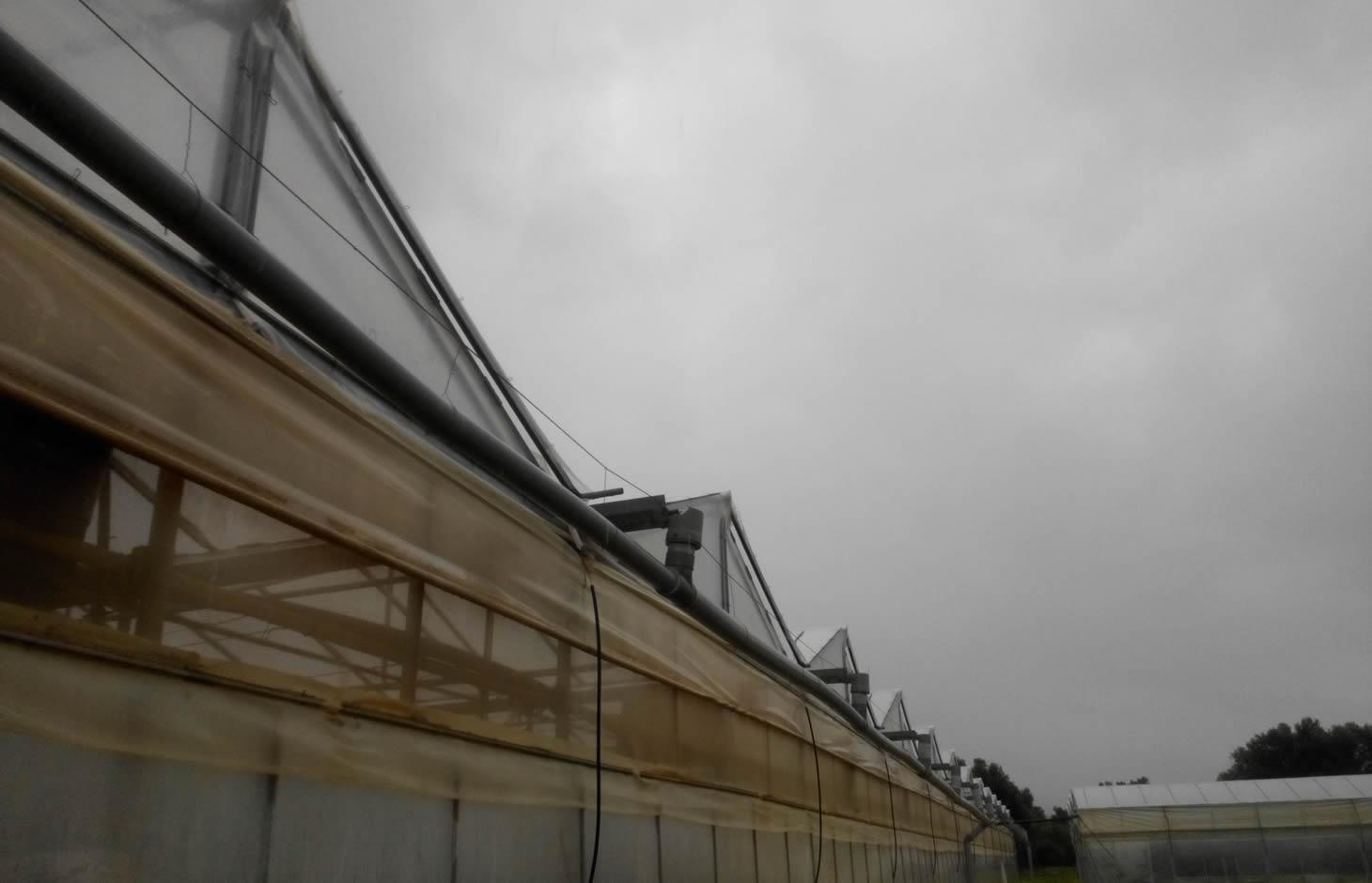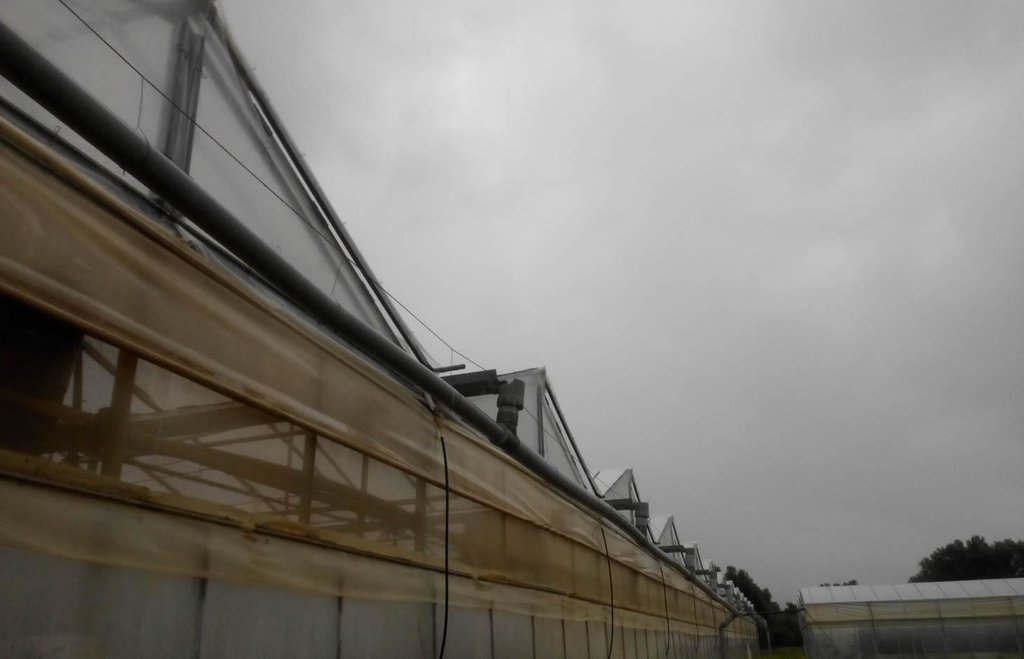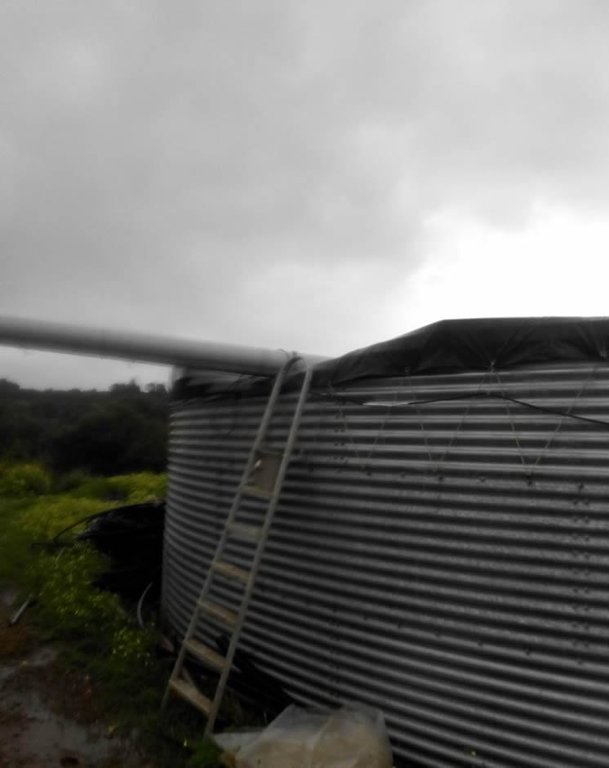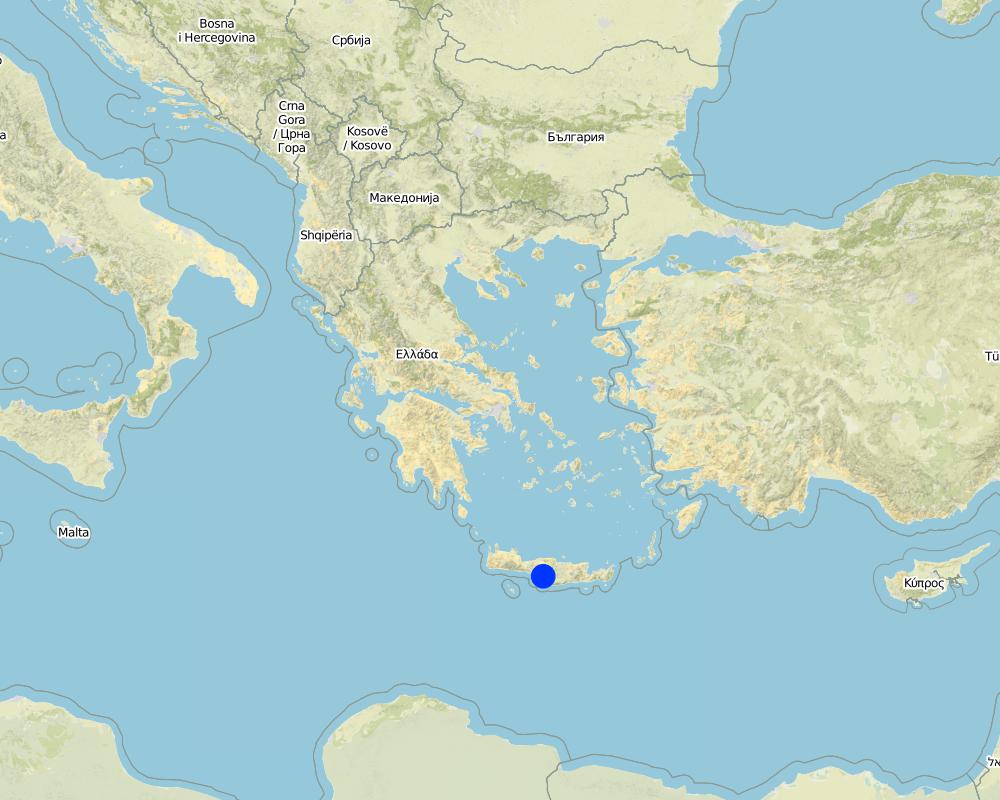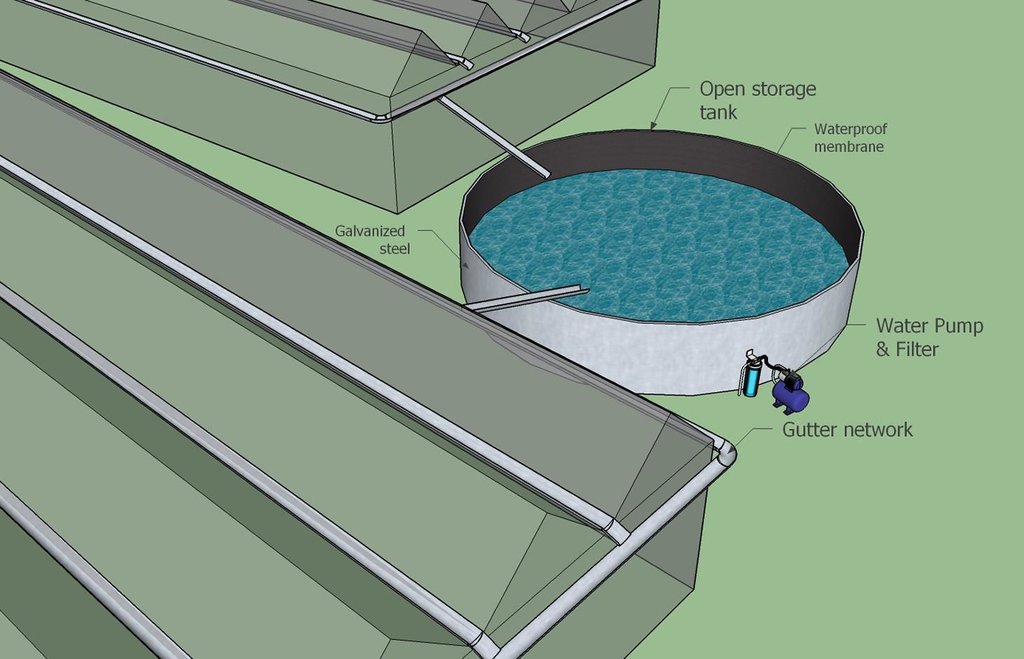Rainwater harvesting for greenhouse irrigation [اليونان]
- تاريخ الإنشاء:
- تحديث:
- جامع المعلومات: Ioanna Panagea
- المحرر: –
- المراجعون: Deborah Niggli, Alexandra Gavilano
Σύστημα συγκομιδής ομβρίων υδάτων από θερμοκήπια με σκοπό την άρδευση
technologies_1658 - اليونان
عرض الأقسام
توسيع الكل طي الكل1. معلومات عامة
1.2 تفاصيل الاتصال بالأشخاص الرئيسيين لمصدر المعلومات والمؤسسات المشاركة في تقييم وتوثيق التقنية
متخصص في الإدارة المستدامة للأراضي:
اسم المشروع الذي سهّل توثيق/تقييم التقنية (إذا كان ذلك على صلة)
Preventing and Remediating degradation of soils in Europe through Land Care (EU-RECARE )اسم المؤسسة (المؤسسات) التي سهلت توثيق/تقييم التقنية (إذا كان ذلك على صلة)
Technical University of Crete (Technical University of Crete) - اليونان1.3 الشروط المتعلقة باستخدام البيانات الموثقة من خلال WOCAT
يوافق جامع المعلومات والشخص (لاشخاص) الرئيسي لمصدر المعلومات على الشروط المتعلقة باستخدام البيانات الموثقة من خلال WOCAT:
نعم
1.4 إعلان بشأن استدامة التقنية الموصوفة
هل التقنية الموصوفة هنا تمثل مشكلة فيما يتعلق بتدهور الأراضي، بحيث لا يمكن إعلانها تقنية مستدامة لإدارة الأراضي؟:
كلا
2. وصف تقنيةالإدارة المستدامي للأراضي
2.1 وصف مختصر للتقنية
تعريف التقنية:
Rain water harvesting from greenhouses roofs.
2.2 وصف تفصيلي للتقنية
الوصف:
The roof of a greenhouse is used as catchment area for rainwater harvesting. A system of gutters is installed to channel water into a storage facility that can be either above ground or at ground level, open or covered. The water harvested from the roofs is used for irrigation purposes, either on its own or mixed with other sources.
In central and eastern Crete, a negative water balance emerges due to agricultural exploitation and lack of sustainable water resources management. Regarding water availability, it is notable that the spatial and temporal variability of precipitation are the limiting factors, rather than overall precipitation quantity. Especially in coastal areas where the main source of irrigation is groundwater, seawater intrusion often takes place, and eventually leading to irrigation with saline water. In the intensive agriculture and water stress conditions existing in greenhouses this situation can progressively lead to soil salinisation with subsequent adverse effects on production. The technology promotes sustainable land management through prevention and mitigation of land degradation by increasing water resources self-sufficiency thus allowing the user to rely less on the scarce groundwater resources and reduce the risk of production failure. Furthermore, the technology improves the overall irrigation water quality. The main disadvantage of the technology is the increase of agricultural inputs (fertilizers) because of the lack of minerals necessary for the crops (especially tomatoes) in the rainwater. This disadvantage can be mitigated by mixing rainwater with other sources.
The majority of the greenhouses in the region normally have built-in gutters between the basic construction units in order to discharge rainwater from the roof for structural safety. Thus, initially little structural measures are required including the implementation of some further gutters that channel rainwater in the storage system and preparation of the area for the tank installation. Overland tanks may consist of galvanized steel or similar material. Ground level storage usually requires earth removal. In both case, the installation of the relevant waterproofing material is required to avoid leaks. A cover may also be installed to reduce evaporation. Here we assess the use of a harvesting system comprising of (a) an above ground circular tank made out of galvanized steel with total volume of 320 m3 and (b) a gutter network spreading on the roof of a 0.7 ha greenhouse. Furthermore, a water filter and water treatment may be required for removal of particles and waterborne disease mitigation. Finally, a suitable pump and mixing facilities are installed to control water quality and quantity.
The average annual precipitation in the area is 500 mm and the climate ranges between sub-humid Mediterranean and semi-arid. Average annual temperature is 18.5 °C with 6 months below 18 °C but above 5 °C, thus classifying the area as subtropical. In the location where the technology is applied, land is mostly privately owned and water rights can be public, cooperative or private. Although the financial means of the land user who applies this technology are more or less on par with those of the rest of the community, he has a wider empirical education and relatively higher social status acquired thought his involvement with the commons and the water resources management of the region.
This Technology was documented within the scope of FP7 RECARE Project, funded grant agreement no 603498.
2.3 صور التقنية
2.5 البلد/المنطقة/المواقع التي تم تنفيذ التقنية فيها والتي يغطيها هذا التقييم
البلد:
اليونان
المنطقة/الولاية/المحافظة:
Heraklion
مزيد من التفاصيل حول الموقع:
Timpaki
التعليقات:
Total area covered by the SLM Technology is 0.007 km2.
Map
×2.6 تاريخ التنفيذ
في حالة عدم معرفة السنة بالتحديد، يرجى الإشارة إلى التاريخ التقريبي:
- منذ 10-50 سنة
2.7 إدخال التقنية
حدد كيف تم إدخال التقنية:
- من خلال المشاريع/ التدخلات الخارجية
التعليقات (نوع المشروع، الخ):
The land user has implemented the water harvesting technology in order to be subsidized from an agri-environmental scheme under the CAP.
3. تصنيف تقنية الإدارة المستدامي للأراضي
3.2 نوع (أنواع) استخدام الأراضي الحالية حيث يتم تطبيق التقنية

الأراضي الزراعية
- زراعة سنوية
- tomatoes
عدد مواسم الزراعة في السنة:
- 1
حدد:
Longest growing period in days: 270, Longest growing period from month to month: October to June

المستوطنات والبنية التحتية
- المستوطنات والمباني
التعليقات:
Major land use problems (compiler’s opinion): The main problem in the region is the change in the groundwater quality, caused by groundwater over-exploitation and the subsequent seawater intrusion, resulting in soil salinisation through irrigation.
Major land use problems (land users’ perception): The limited availability of good quality (non-saline) water for irrigation resulting in increased production risk and agricultural inputs.
3.4 إمدادات المياه
إمدادات المياه للأرض التي يتم تنفيذ التقنية عليها:
- ري كامل
3.5 مجموعةالإدارة المستدامة للأراضي التي تنتمي إليها هذه التقنية
- حصاد المياه
- إدارة الري (بما في ذلك إمدادات المياه والصرف الصحي)
3.6 التدابير التقنية في مجال إلادارة المستدامة للأراضي

التدابير البنيوية
- S5: السدود، الأحواض الصغيرة، البرك
- S11: غير ذلك
التعليقات:
Main measures: structural measures
Specification of other structural measures: Greenhouse roof gutter network
3.7 الأنواع الرئيسية من تدهور الأراضي التي تناولتها التقنية

التدهور الكيميائي للتربة
- (Cs): التملح/ القلونة

التدهور البيولوجي
- (Bq): انخفاض الكمية/الكتلة الحيوية

تدهور المياه
- (Hg): التغير في مستوى المياه الجوفية/الطبقة المائية الجوفية
التعليقات:
Main type of degradation addressed: Cs: salinisation / alkalinisation, Hg: change in groundwater / aquifer level
Secondary types of degradation addressed: Bq: quantity / biomass decline
Main causes of degradation: over abstraction / excessive withdrawal of water (for irrigation, industry, etc.) (Overpumping.), other human induced causes (specify) (Irrigation with brackish water.), droughts (Lack of sustainable water resources.), inputs and infrastructure: (roads, markets, distribution of water points, other, …) (Poor coverage of freshwater irrigation network.)
Secondary causes of degradation: soil management (Intensive cultivation), disturbance of water cycle (infiltration / runoff) (Covering of land with green houses decreases leaching.)
3.8 منع أو حد أو عكس تدهور الأراضي
تحديد هدف التقنية فيما يتعلق بتدهور الأراضي:
- منع تدهور الأراضي
- الحد من تدهور الأراضي
4. المواصفات الفنية، وأنشطة التنفيذ، والمدخلات، والتكاليف
4.1 الرسم الفني للتقنية
المواصفات الفنية (المتعلقة بالرسم الفني):
A network of gutters channels rainwater to an adequately insulated metal tank. The stored water is then used for irrigation.
Location: Timpaki. Heraklion, Crete, Greece
Date: 31/3/2015
Technical knowledge required for field staff / advisors: moderate
Technical knowledge required for land users: moderate
Main technical functions: water harvesting / increase water supply, improvement of water quality, buffering / filtering water
Secondary technical functions: increase of groundwater level / recharge of groundwater
Dam/ pan/ pond
Height of bunds/banks/others (m): 2.7
Width of bunds/banks/others (m): 12.3
Structural measure: gutter network
Length of bunds/banks/others (m): 210
Construction material (other): Plastic gutters on the greenhouses roofs, galvanized steel & wateproof membrane for the tank
Specification of dams/ pans/ ponds: Capacity 320m3
Catchment area: 7000m2m2
Beneficial area: 7000m2m2
For water harvesting: the ratio between the area where the harvested water is applied and the total area from which water is collected is: 1:1
المؤلف:
Ioannis Daliakopoulos
4.2 معلومات عامة بخصوص حساب المدخلات والتكاليف
عملة أخرى/ عملة وطنية (حدد):
Euro
إذا كان ذا صلة، وضح سعر الصرف من الدولار الأمريكي إلى العملة المحلية (على سبيل المثال، 1 دولار أمريكي = 79.9 ريال برازيلي): 1 دولار أمريكي =:
0,93
4.3 أنشطة التأسيس
| النشاط | التوقيت (الموسم) | |
|---|---|---|
| 1. | Construction of the tank base (including material transportation) | |
| 2. | Tank construction (including material transportation) | |
| 3. | Installation of the plastic gutters | |
| 4. | Pump and cleaning filter |
4.4 التكاليف والمدخلات اللازمة للتأسيس
| تحديد المدخلات | الوحدة | الكمية | التكاليف لكل وحدة | إجمالي التكاليف لكل مدخل | % من التكاليف التي يتحملها مستخدمو الأراضي | |
|---|---|---|---|---|---|---|
| العمالة | Labour | 1,0 | 858,0 | 858,0 | 60,0 | |
| معدات | pump | 1,0 | 536,0 | 536,0 | 60,0 | |
| معدات | cleaning filter | 1,0 | 536,0 | 536,0 | 60,0 | |
| مواد البناء | galvanized steel | 1,0 | 3379,0 | 3379,0 | 60,0 | |
| مواد البناء | waterproof membrane | 1,0 | 2360,0 | 2360,0 | 60,0 | |
| مواد البناء | sand | 1,0 | 675,0 | 675,0 | 60,0 | |
| مواد البناء | concrete | 1,0 | 290,0 | 290,0 | 60,0 | |
| غير ذلك | gutters | 1,0 | 2252,0 | 2252,0 | 60,0 | |
| إجمالي تكاليف إنشاء التقنية | 10886,0 | |||||
| إجمالي تكاليف إنشاء التقنية بالدولار الأمريكي | 11705,38 | |||||
التعليقات:
Duration of establishment phase: 0.5 month(s)
4.5 الصيانة/الأنشطة المتكررة
| النشاط | التوقيت/الوتيرة | |
|---|---|---|
| 1. | Maintenance costs are negligible, e.g. filters are cleaned with water when needed. Fuel can't be accurately estimated as it depends on the machine hours that the pump works to irrigate. Two considerations: 1.Practically, the pump would have to work regardless of the water harvesting system. 2.The water harvesting system is irrelevant of the pumping scheme. |
4.6 التكاليف والمدخلات اللازمة للصيانة/للأنشطة المتكررة (سنويًا)
التعليقات:
The cost described are calculated in current prices for the whole construction.
4.7 أهم العوامل المؤثرة على التكاليف
قدم وصفا لأهم العوامل التي تؤثر على التكاليف:
The greater deterrent against implementing the technology is the high cost of the tank construction.
5. البيئة الطبيعية والبشرية
5.1 المناخ
هطول الأمطار السنوي
- < 250 مم
- 251- 500 ملم
- 501 - 750ملم
- 1,000-751 ملم
- 1,500-1,100 ملم
- 2,000-1,500 ملم
- 3,000-2,001 ملم
- 4,000-3,100 ملم
- > 4000 ملم
المواصفات/التعليقات على هطول الأمطار:
About 400-500 mm annually
المنطقة المناخية الزراعية
- شبه رطبة
- شبه قاحلة
Thermal climate class: subtropics. 6 months below 18 °C but above 5 °C
5.2 طوبوغرافيا
متوسط الانحدارات:
- مسطح (0-2%)
- بسيط (3-5%)
- معتدل (6-10%)
- متدحرج (11-15%)
- تلال (16-30%)
- شديدة الانحدار(31-60%)
- فائقة الانحدار (>60%)
التضاريس:
- هضاب/سهول
- أثلام مرتفعة
- المنحدرات الجبلية
- منحدرات التلال
- منحدرات في السفوح
- قاع الوادي
المنطقة الارتفاعية:
- 100-0 متر فوق سطح البحر
- 500-101 متر فوق سطح البحر
- 1,000-501 متر فوق سطح البحر
- 1,500-1,001 متر فوق سطح البحر
- 2,000-1,501 متر فوق سطح البحر
- 2,500-2,100 متر فوق سطح البحر
- 3,000-2,501 متر فوق سطح البحر
- 4,000-3,001 متر فوق سطح البحر
- > 4000 متر فوق سطح البحر
5.3 التربة
متوسط عمق التربة:
- ضحل جدًا (0-20 سم)
- ضحلة (21-50 سم)
- متوسطة العمق (51-80 سم)
- عميقة (81-120 سم)
- عميقة جدًا (> 120 سم)
قوام التربة (التربة السطحية):
- متوسط ( طميي، سلتي)
المواد العضوية في التربة السطحية:
- عالية (>3%)
إذا كان متاحًا، قم بإرفاق وصف كامل للتربة أو تحديد المعلومات المتوفرة، على سبيل المثال نوع التربة، الرقم الهيدروجيني/ درجة حموضة التربة، قدرة التبادل الكاتيوني، النيتروجين، الملوحة وما إلى ذلك.
Soil texture characterized mainly as sandy clay loam or clay loam
5.4 توافر المياه ونوعيتها
منسوب المياه الجوفية:
50-5 م
توافر المياه السطحية:
متوسط
نوعية المياه (غير المعالجة):
للاستخدام الزراعي فقط (الري)
تعليقات ومواصفات أخرى بشأن نوعية المياه وكميتها:
Water quality (treated): good drinking water
5.5 التنوع البيولوجي
تنوع الأنواع:
- منخفض
5.6 خصائص مستخدمي الأراضي الذين يطبقون التقنية
مستقر أو مرتحل:
- غير المترحل
التوجه السوقي لنظام الإنتاج:
- تجاري/سوق
الدخل من خارج المزرعة:
- أقل من % 10من كامل الدخل
المستوى النسبي للثروة:
- متوسط
- ثري
أفراداً أو مجموعات:
- فرد/أسرة معيشية
مستوى المكننة:
- عمل يدوي
- ميكانيكية/ مزودة بمحرك
الجنس:
- رجال
اذكر الخصائص الأخرى ذات الصلة لمستخدمي الأراضي:
Land users applying the Technology are mainly common / average land users
Population density: 10-50 persons/km2
Annual population growth: 1% - 2%
5.7 متوسط مساحة الأرض التي يستخدمها مستخدمو الأراضي الذين يطبقون التقنية
- < 0.5 هكتارا
- 0.5 - 1 هكتار
- 1 -2 هكتار
- 2 - 5 هكتار
- 5 - 15 هكتار
- 15 - 50 هكتار
- 50 - 100هكتار
- 500-100 هكتار
- 1,000-500 هكتار
- 10,000-1,000 هكتار
- > 10,000 هكتار
هل يعتبر هذا نطاقًا صغيرًا أو متوسطًا أو واسعا (في إشارة إلى السياق المحلي)؟:
- على نطاق متوسط
5.8 ملكية الأراضي، وحقوق استخدام الأراضي، وحقوق استخدام المياه
ملكية الارض:
- فردية، يوجد سند ملكية
حقوق استخدام الأراضي:
- مؤجر
- فردي
- Cooperative
حقوق استخدام المياه:
- مجتمعي (منظم)
- فردي
- Cooperative
5.9 الوصول إلى الخدمات والبنية التحتية
الصحة:
- ضعيف
- معتدل
- جيد
التعليم:
- ضعيف
- معتدل
- جيد
المساعدة التقنية:
- ضعيف
- معتدل
- جيد
العمل (على سبيل المثال خارج المزرعة):
- ضعيف
- معتدل
- جيد
الأسواق:
- ضعيف
- معتدل
- جيد
الطاقة:
- ضعيف
- معتدل
- جيد
الطرق والنقل:
- ضعيف
- معتدل
- جيد
مياه الشرب وخدمات الصرف الصحي:
- ضعيف
- معتدل
- جيد
الخدمات المالية:
- ضعيف
- معتدل
- جيد
6. الآثار والتصريحات الختامية
6.1 الآثار التي أظهرتها التقنية في الموقع
الآثار الاجتماعية والاقتصادية
الإنتاج
إنتاج المحاصيل
خطر فشل الإنتاج
الدخل والتكاليف
النفقات على المدخلات الزراعية
التعليقات/ حدد:
softer water (rainwater) requires more expensive fertilisers
آثار اجتماعية واقتصادية أخرى
production area
التعليقات/ حدد:
Depending on relative farm size.
الآثار الاجتماعية والثقافية
الأمن الغذائي / الاكتفاء الذاتي
المعرفة بالإدارة المستدامة للأراضي/تدهور الأراضي
Contribution to human well-being
التعليقات/ حدد:
The technology reduces production risk and increases self sufficiency for the user who implements it. If the technology is widely implemented this will have a positive impact on the soil sustainability of the area thus allowing agricultural exploitation for longer. It will also greatly reduce water use conflicts, thus contributing to the general well-being of the local community.
الآثار الايكولوجية
دورة المياه / الجريان السطحي
كمية المياه
جودة المياه
حصاد / جمع المياه
التربة
رطوبة التربة
الملوحة
6.2 الآثار التي أظهرتها التقنية خارج الموقع
توافر المياه
الأضرار التي لحقت بحقول الجيران
التعليقات/ حدد:
control of the water from the greenhouses roofs.
الضرر على البنية التحتية العامة/ الخاصة
التعليقات/ حدد:
control of the water from the greenhouses roofs.
6.3 تعرض التقنية وحساسيتها لتغير المناخ التدريجي والظواهر المتطرفة/الكوارث المرتبطة بالمناخ (كما يراها مستخدمو الأراضي)
تغير مناخ تدريجي
تغير مناخ تدريجي
| الموسم | زيادة أو نقصان | كيف تتعامل التقنية مع ذلك؟ | |
|---|---|---|---|
| درجة الحرارة السنوية | زيادة | جيدا |
الظواهر المتطرفة / الكوارث المرتبطة بالمناخ
الكوارث المناخية
| كيف تتعامل التقنية مع ذلك؟ | |
|---|---|
| جفاف | ليس جيدا |
العواقب الأخرى المتعلقة بالمناخ
العواقب الأخرى المتعلقة بالمناخ
| كيف تتعامل التقنية مع ذلك؟ | |
|---|---|
| Decrease of water temperature | ليس جيدا |
التعليقات:
The optimum water temperature for the crops cultivated in the greenhouse (tomatoes) is about 20 °C. If water temperature is less than 14 °C then the land user has to rely on an alternative source.
6.4 تحليل التكلفة والعائد
كيف يمكن مقارنة العوائد نسبة لتكاليف الإنشاء (من وجهة نظر مستخدمي الأراضي)؟
عوائد قصيرة الأجل:
سلبي
عوائد طويلة الأجل:
إيجابي
كيف تتم مقارنة العوائدمع كلفة الصيانة/التكاليف المتكررة (من وجهة نظر مستخدمي الأراضي)؟
عوائد قصيرة الأجل:
إيجابي
عوائد طويلة الأجل:
ايجابي جدا
التعليقات:
In the long term soil health is greatly maintained.
6.5 اعتماد التقنية
- > 50%
إذا كان متاحًا، قم بتحديد الكمية (عدد الأسر المعيشية و/أو المساحةالمغطاة):
70% or 7 land user families
من بين جميع الذين تبنوا التقنية، كم عدد الذين فعلوا ذلك بشكل تلقائي، أي دون تلقي أي حوافز مادية/مدفوعات؟:
- 11-50%
التعليقات:
30% of land user families have adopted the Technology without any external material support
3 land user families have adopted the Technology without any external material support
Comments on spontaneous adoption: Land users are probably not able to afford or justify the cost without external material support.
There is a little trend towards spontaneous adoption of the Technology
Comments on adoption trend: Word of mouth conveys the successful results and several users are eager to adopt the technology but not without external material support.
6.7 نقاط القوة / المزايا / الفرص التي توفرها التقنية
| نقاط القوة/ المزايا/ الفرص من وجهة نظر مستخدمي الأراضي |
|---|
| Increased irrigation water availability, and security; reduced crop failure risk; ability to diversify or intensify production |
| نقاط القوة/ المزايا/ الفرص من وجهة نظر جامع المعلومات أو غيره من الاشخاص الرئيسيين لمصدر المعلومات |
|---|
| Self-sufficiency of water; sustainable agriculture management (soil protection and conservation) and reduced failure risk; decreased soil salinity |
6.8 نقاط ضعف / مساوىء / مخاطر التقنية وسبل التغلب عليها
| نقاط الضعف/ المساوىء/ المخاطر من وجهة نظر مستخدم الأراضي | كيف يمكن التغلب عليها؟ |
|---|---|
| High construction cost. | The construction of a water harvesting system for greenhouses can be subsidized. |
| Tomato cultivation requires water with higher electric conductivity than that of rainwater, therefore increased agricultural inputs may be required to treat the harvested rainwater. | Rainwater may be mixed with brackish water at a prescribed ratio. |
| نقاط الضعف/ المساوىء/ المخاطر من وجهة نظر جامع المعلومات أو غيره من الاشخاص الرئيسيين لمصدر المعلومات | كيف يمكن التغلب عليها؟ |
|---|---|
| Is dependent on climatic conditions (precipitation/evaporation) | During dry years the storage tank can be used as a buffer from other sources. Installing a cover reduces evaporation. |
| High construction cost. | The construction of a water harvesting system for greenhouses can be made obligatory. |
| The storage area decreases the area available for cultivation (or can't be established in very small properties) |
7. المراجع والروابط
7.1 طرق جمع/مصادر المعلومات
- زيارات ميدانية، مسوحات ميدانية
- مقابلات مع مستخدمي الأراضي
متى تم تجميع البيانات (ميدانيا)؟:
06/03/2015
الروابط والوحدات المواضيعية
توسيع الكل طي الكلالروابط
لا يوجد روابط
الوحدات المواضيعية
لا يوجد وحدات مواضيعية


